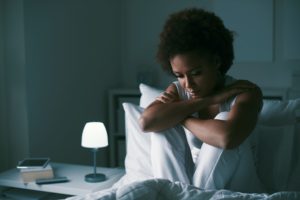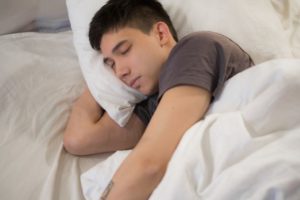Idiopathic Hypersomnia
Idiopathic hypersomnia is a condition in which a person is excessively sleepy for no identifiable reason. A person with idiopathic hypersomnia may feel tired during the day, sleep longer than usual at night, or take long naps but wake up still feeling tired.
Because of their symptoms, people with idiopathic hypersomnia may find it difficult to meet work, academic, or social obligations. Idiopathic hypersomnia can also increase the risk of sleepiness-related accidents such as car crashes.
What Is Idiopathic Hypersomnia?
Idiopathic hypersomnia (IH) is a rare sleep disorder characterized by feelings of excessive tiredness and difficulties getting up in the morning or after a nap. As a sleep disorder, idiopathic hypersomnia is classified under the broader category of central disorders of hypersomnolence, the same group that contains the sleep disorders narcolepsy and Kleine-Levin syndrome.
Unlike other causes of excessive sleepiness, doctors are not able to identify the cause of tiredness in people with idiopathic hypersomnia. For these people, excessive sleepiness is not caused by sleep loss, a medical or mental health condition, or another sleep disorder.
Idiopathic hypersomnia often begins in late adolescence or early adulthood. Symptoms often develop slowly, becoming more noticeable over a period of a few weeks or months. Diagnosing the condition can be challenging and, for many people, there are several years between the onset of symptoms and getting a diagnosis of idiopathic hypersomnia.
How Rare Is Idiopathic Hypersomnia?
Experts are not sure how many people have idiopathic hypersomnia. It is estimated that IH may occur in around 20 to 50 out of every million people. It is difficult to determine how many people have idiopathic hypersomnia because specialized testing is often needed to rule out other health issues with similar symptoms.
Idiopathic Hypersomnia Symptoms
A common symptom of idiopathic hypersomnia is excessive daytime sleepiness, which may be so severe that a person finds it difficult or impossible to make it through the day without falling asleep. Naps often last for an hour or more, and most people with idiopathic hypersomnia report that even prolonged naps do not relieve their feelings of sleepiness.
Although sleeping for long periods at night is not a requirement of the disorder, people with idiopathic hypersomnia typically sleep for at least 11 hours each day, often resting for as long as 12 to 14 hours in a single 24-hour period.
One-third to two-thirds of people with idiopathic hypersomnia also experience symptoms of severe sleep inertia. Sleep inertia describes waking up feeling groggy and disoriented. In people with idiopathic hypersomnia, sleep inertia may involve repeatedly falling back asleep or feeling confused and irritable. During periods of sleep inertia, a person with idiopathic hypersomnia may also perform activities automatically, with little or no knowledge of what they did after fully waking up.
People with idiopathic hypersomnia may also experience:
- Dizziness or lightheadedness when standing up
- Headaches
- Feeling too hot or too cold
- Brief episodes of sleep paralysis
- Hallucinations when falling asleep or waking up
- Brain fog , or trouble with memory and attention
Causes of Idiopathic Hypersomnia
The exact origin of idiopathic hypersomnia is unknown, and research suggests that the condition may have several causes.
Genetics
Studies suggest that the development of idiopathic hypersomnia may be influenced by genetics. In fact, around half of people with idiopathic hypersomnia have a family member with the same condition or another central disorder of hypersomnolence like narcolepsy, suggesting a genetic basis for the disorder. Research has uncovered several possible genes that could be responsible for the condition’s development.
Nervous System Dysfunction
Because idiopathic hypersomnia is often accompanied by physical symptoms such as headaches and problems with temperature regulation, some experts believe idiopathic hypersomnia might be tied to issues with the autonomic nervous system. The autonomic nervous system is responsible for processes in the body that are not consciously controlled, such as body temperature, weight, heart rate, and digestion.
Autoimmune Disease
For some people, symptoms of idiopathic hypersomnia may appear for the first time after a viral illness. Based on this finding, researchers have proposed that idiopathic hypersomnia may represent an autoimmune condition. Autoimmune diseases are a group of conditions in which the body mistakenly combats its own healthy cells.
The GABA-A Network
Some experts suspect that idiopathic hypersomnia arises due to increased activation of nerve cells with GABA-A receptors . GABA-A is a neurotransmitter responsible for dampening nervous system activity levels. Researchers have proposed that people with IH may have an extra substance in their cerebrospinal fluid that promotes sleepiness by intensifying GABA-A activity.
How Is Idiopathic Hypersomnia Diagnosed?
To diagnose idiopathic hypersomnia, a doctor will consider a person’s medical history, symptoms, and the results of tests used to rule out other causes of excessive tiredness. To track a person’s symptoms, a doctor may recommend keeping a sleep diary or using actigraphy to track time spent in bed, sleeping, and doing other activities.
In order to be diagnosed with idiopathic hypersomnia, a person must experience strong urges to sleep, or instances of falling asleep during the day, every day for three months or longer. To ensure that sleepiness is not caused by another condition, a doctor must then rule out sleep deprivation and make sure that there is no evidence of cataplexy, which describes when a person suddenly loses muscle tone without losing consciousness.
To confirm the diagnosis, doctors then use polysomnography and multiple sleep latency testing to determine whether a person has an increased need for sleep and how quickly they enter rapid-eye movement (REM) sleep.
Polysomnography
An all-night sleep study called polysomnography is recommended to exclude other medical conditions and sleep disorders. Because polysomnography analyzes sleep quality as well as physiological markers while a person sleeps, it can help to rule out conditions such as sleep apnea or narcolepsy.
During polysomnography, people with idiopathic hypersomnia usually fall asleep quickly, sleep for a long time, and may show certain unusual characteristics in how they move through the sleep stages.
Multiple Sleep Latency Test
Doctors may also conduct a multiple sleep latency test. This test is usually carried out during the day, right after polysomnography is completed, so that doctors can be sure the results of the test are not affected by lack of sleep the night before the test.
The multiple sleep latency test offers five opportunities to nap throughout the day and measures how long it takes a person to fall asleep during each nap. People with idiopathic hypersomnia usually fall asleep in less than eight minutes during the test, which is quicker than most people without this condition.
Idiopathic Hypersomnia vs. Narcolepsy
Like idiopathic hypersomnia, narcolepsy is a sleep disorder characterized by persistent sleepiness during the day . Narcolepsy is a chronic condition that impairs the body’s ability to regulate when people are awake and when they sleep.
While these conditions have similarities, narcolepsy often involves the symptom of cataplexy, in which a person is still awake but briefly loses the ability to control their muscles. Other key distinctions between idiopathic hypersomnia and narcolepsy include how quickly a person falls asleep and when they enter REM sleep.
People with idiopathic hypersomnia tend to fall asleep quickly. In narcolepsy, people slip almost immediately into REM sleep instead of first passing through the other sleep stages.
Researchers have proposed a short questionnaire, the Idiopathic Hypersomnia Severity Scale, to help doctors diagnose idiopathic hypersomnia and determine whether a person more likely has idiopathic hypersomnia or narcolepsy.
Treatment for Idiopathic Hypersomnia
Since the root cause of the condition is unknown, treatment for idiopathic hypersomnia is recommended to manage symptoms. This means that treatment focuses on addressing symptoms rather than treating the conition’s underlying cause.
For about one in five people with idiopathic hypersomnia, symptoms may resolve on their own over time. In other cases, doctors may recommend medications to treat excessive sleepiness, tiredness, and other symptoms.
Medication
The Food and Drug Administration (FDA) recently approved the first medication for treating idiopathic hypersomnia . Doctors may also prescribe medications off-label that are also used to treat other conditions.
Medications that may be recommended include certain central nervous system depressants, stimulants, antibiotics, and sedatives. Many of these medications are used to address the symptom of daytime sleepiness . However, more research is needed to establish the best medication for treating idiopathic hypersomnia.
Tips for Living with Idiopathic Hypersomnia
Excessive sleepiness and other symptoms of idiopathic hypersomnia can make it challenging to keep up with obligations at work, school, and in a person’s social life. Several tips may be helpful in adjusting to life with idiopathic hypersomnia.
- Be careful with dangerous activities: Excessive sleepiness can make certain activities more dangerous, so people with idiopathic hypersomnia should be careful to avoid operating a car, using heavy machinery, or other risky activities when they are tired.
- Ask for accommodations: For people experiencing brain fog or challenges at work or school, it may be helpful to reach out to teachers and colleagues to ask for later start time or more time to complete tests and assignments.
- Find support: Support groups can help people with idiopathic hypersomnia learn skills and strategies that have worked for others and combat feelings of isolation.
- Schedule regular follow-ups: Experts recommend that people with idiopathic hypersomnia schedule follow-up appointments with their doctor every 6 to 12 months. These visits are important to reassess the efficacy and side effects of medication as well as to discuss any changes in symptoms.
Medical Disclaimer: The content on this page should not be taken as medical advice or used as a recommendation for any specific treatment or medication. Always consult your doctor before taking a new medication or changing your current treatment.
References
9 Sources
-
Dhillon, K. & Sankari, A. (2022, August 2). Idiopathic hypersomnia. In StatPearls. StatPearls Publishing., Retrieved November 15, 2022, from
https://www.ncbi.nlm.nih.gov/books/NBK585065/ -
Trotti L. M. (2017). Idiopathic hypersomnia. Sleep Medicine Clinics, 12(3), 331–344.
https://pubmed.ncbi.nlm.nih.gov/28778232/ -
Schwab, R. J. (2022, May). Idiopathic hypersomnia. Merck Manual Professional Version., Retrieved November 15, 2022, from
https://www.merckmanuals.com/professional/neurologic-disorders/sleep-and-wakefulness-disorders/idiopathic-hypersomnia -
Trotti, L. M., Ong, J. C., Plante, D. T., Friederich Murray, C., King, R., & Bliwise, D. L. (2020). Disease symptomatology and response to treatment in people with idiopathic hypersomnia: Initial data from the Hypersomnia Foundation registry. Sleep Medicine, 75, 343–349.
https://pubmed.ncbi.nlm.nih.gov/32950878/ -
Chervin, R. D. (2022, January 1). Idiopathic hypersomnia. In T. E. Scammell (Ed.). UpToDate., Retrieved November 15, 2022, from
https://www.uptodate.com/contents/idiopathic-hypersomnia -
Trotti, L. M., & Arnulf, I. (2021). Idiopathic hypersomnia and other hypersomnia syndromes. Neurotherapeutics, 18(1), 20–31.
https://pubmed.ncbi.nlm.nih.gov/32901432/ -
National Institute of Neurological Disorders and Stroke. (2022, September 22). Narcolepsy fact sheet., Retrieved November 18, 2022, from
https://www.ninds.nih.gov/narcolepsy-fact-sheet -
Trotti L. M. (2022). Idiopathic hypersomnia: Does first to approval mean first-line treatment?. The Lancet. Neurology, 21(1), 25–26.
https://pubmed.ncbi.nlm.nih.gov/34942131/ -
Maski, K., Trotti, L. M., Kotagal, S., Robert Auger, R., Rowley, J. A., Hashmi, S. D., & Watson, N. F. (2021). Treatment of central disorders of hypersomnolence: An American Academy of Sleep Medicine clinical practice guideline. Journal of Clinical Sleep Medicine, 17(9), 1881–1893.
https://pubmed.ncbi.nlm.nih.gov/34743789/





